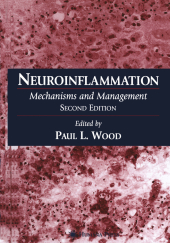 Neuerscheinungen 2012Stand: 2020-01-07 |
Schnellsuche
ISBN/Stichwort/Autor
|
Herderstraße 10
10625 Berlin
Tel.: 030 315 714 16
Fax 030 315 714 14
info@buchspektrum.de |

Paul L. Wood
Neuroinflammation
Mechanisms and Management
Herausgegeben von Wood, Paul L.
2. Aufl. 2012. xii, 420 S. 48 SW-Abb., 5 Farbabb. 254 mm
Verlag/Jahr: SPRINGER, BERLIN; HUMANA PRESS 2012
ISBN: 1-468-49720-0 (1468497200)
Neue ISBN: 978-1-468-49720-5 (9781468497205)
Preis und Lieferzeit: Bitte klicken
In this thoroughly updated and revised edition of his much praised book, Paul L. Wood and a panel of leading researchers capture these new developments in a masterful synthesis of what is known today about the inflammatory mediators and cells involved in neurodegenerative diseases. This second edition contains extensive updates on the mediators produced by microglia and their role in neuroinflammatory-induced neuronal lysis. There is also increased coverage of the animal models used in the study of neuroinflammatory mechanisms, of the new imaging methods that allow the noninvasive evaluation of microglial activation in human neurodegernerative disorders, and of the role of neuroinflammation in amyloid-dependent neuronal lysis.
I. Neuroinflammatory Mechanisms
Microglia: Roles of Microglia in Chronic Neurodegenerative Diseases
Paul L. Wood
Apoptosis vs Nonapoptotic Mechanisms in Neurodegeneration
Kurt A. Jellinger
Role(s) of Mitogen and Stress-Activated Kinases in Neurodegeneration
Christopher C. J. Miller, Steven Ackerley, Janet Brownlees, Andrew J. Grierson, and Paul Thornhill
Roles of Chemokines and Their Receptors in Neuroinflammation
Andrzej R. Glabinski and Richard M. Ransohoff
Neurotoxic Mechanisms of Nitric Oxide
Kathleen M. K. Boje
Chronic Intracerebral LPS as a Model of Neuroinflammation
Gary L. Wenk and Beatrice Hauss-Wegrzyniak
Peroxisome Proliferator-Activated Receptor Gamma Agonists: Potential Therapeutic Agents for Neuroinflammation
Gary E. Landreth, Sophia Sundararajan, and Michael T. Heneka
Neuroinflammation-Mediated Neurotoxin Production in Neurodegenerative Diseases: Potential of Nitrones as Therapeutics
Robert A. Floyd and Kenneth Hensley
II. Stroke and TBI
Inflammation and Potential Anti-Inflammatory Approaches in Stroke
Jari Koistinaho and Juha Yrjänheikki
Neuroinflammation as an Important Pathogenic Mechanism in Spinal Cord Injury
Yuji Taoka and Kenji Okajima
Type IV Collagenases and Blood-Brain Barrier Breakdown in Brain Ischemia
Yvan Gasche, Jean-Christophe Copin, and Pak H. Chan
III. Alzheimer´s Disease
Neuroinflammatory Environments Promote Amyloid-b Deposition and Posttranslational Modification
Craig S. Atwood, Mark A. Smith, Ralph N. Martins, Rudolph E. Tanzi, Alex E. Roher, Ashley I. Bush, and George Perry
Microglial Responses in Alzheimer´s Disease: Recent Studies in Transgenic Mice and Alzheimer´s Disease Brains
Douglas G. Walker and Lih-Fen Lue
The Amyloid Hypothesis of Cognitive Dysfunction
Dave Morgan and MarciaN. Gordon
The Cerebellum in AD: A Case for Arrested Neuroinflammation?
Paul L. Wood
The Neuroinflammatory Components of the Trimethyltin (TMT) Model of Hippocampal Neurodegeneration
G. Jean Harry and Christian Lefebvre d´Hellencourt
Inflammation and Cyclo-Oxygenase in Alzheimer´s Disease: Experimental Approaches and Therapeutic Implications
Patrick Pompl, Tara Brennan, Lap Ho, and Giulio Maria Pasinetti
IV. Multiple Sclerosis
Experimental Autoimmune Encephalomyelitis
Hans-Peter Hartung and Bernd C. Kieseier
Neuroimmunologic Mechanisms in the Etiology of Multiple Sclerosis
Claudia F. Lucchinetti, W. Brück, and Hans Lassmann
In Vivo Imaging of Neuroinflammation in Neurodegenerative Diseases
Annachiara Cagnin, Alexander Gerhard, and Richard B. Banati
V. Parkinson´s and Huntington´s Diseases
Inflammatory Mechanisms in Parkinson´s Disease
Joseph Rogers and Carl J. Kovelowski
Neuroinflammatory Components of the 3-Nitropropionic Acid Model of Striatal Neurodegeneration
Hideki Hida, Hiroko Baba, and Hitoo Nishino
Index
Review of the first edition:
"...will reach a wide audience including basic and clinical neuroscientists. . .fills a significant gap in the literature...provides an excellent starting point, and offers insight into the rapid pace of discovery within a field which influences most aspects of nervous system function."-Nature Medicine
"...fills a significant gap in the literature...provides an excellent starting point..."
-Nature Medicine
"...will be useful to a wide variety of researchers and clinicians, particularly [those] interested in neurodegenerative disorders ..."
-Neurological Research
"...provides a thorough overview of cells and mechanisms of brain inflammation, their role in disease and future therapeutic avenues to overcome it."
-Microbiology Today
"...a timely addition that will aid our understanding today."
-Receptors & Signal Transduction


